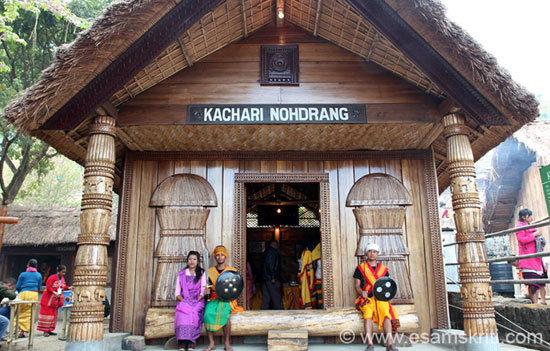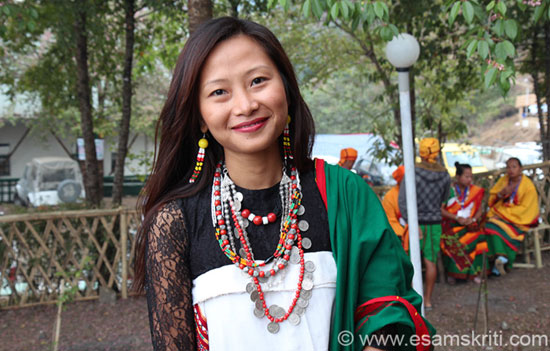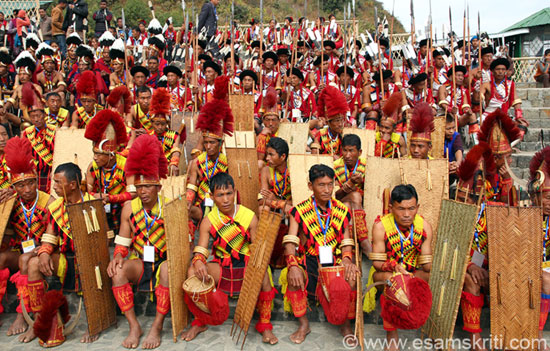- Know about Nagaland’s Hornbill Festival and enjoy
pictures.
The hornbill festival started in the year 2000, is the
most popular festival of Nagaland and is celebrated from 1-10 December every
year. The festival takes place in Naga Heritage Village Kisma which is 12
kilometers from Kohima, the capital city of Nagaland. Village has a Mela type
atmosphere. One can take a taxi from Kohima to the village.
Hornbill is known as “festival of all
festivals”. The event is named after a beautiful bird, the Hornbill. It is a common bird in Nagaland's mythology and tribes, and may frequently be spotted in the state's woodlands.
In 1963, Nagaland was formed from the Assam district
of Naga Hills and the NEFA province.
Having
attended the festival must say it is a must visit. Very colourful, lovely dance
and music. Inspired by Hornill, Manipur have started the Sangai Festival.
 Welcome dance by Phom tribe at Hornbill Festival 2014.
Welcome dance by Phom tribe at Hornbill Festival 2014.The Hornbill Festival is devoted to the cultural activities of Nagaland's tribes. It was created by the Nagaland government to promote inter-tribal cooperation. People from several tribes gather to rejoice during this ten day festival. The goal of this festival is to preserve Nagaland’s cultural legacy.
It
is organized by the state Tourism and Art & Culture Department that showcases
a melange of cultural displays. This festival is the largest
celebration of the indigenous tribes of Nagaland who have a tradition of
maintaining their unique heritage and customs. And for this reason, tourists from
across the world throng Kohima.
During
the festival one can experience the uniqueness that exists in each tribe and spend
time with the locals to understand their culture first-hand. The festival
village has traditional homes of each tribe, their key symbols and people of
that tribe dressed in traditional attire (see pictures below). Every tribe also
has a kitchen where they cook and serve food. You can also dance with and click
pictures with members of each tribe.
The
heritage village is organised tribe wise. Every tribe has a typical house that
belongs to the tribe. We present some pictures for you to get an idea.
 Board gives you brief information about the tribe.
Board gives you brief information about the tribe. An artistically designed gate known as Fangsla, designed during Bishu festival.
An artistically designed gate known as Fangsla, designed during Bishu festival.  Girl dressed in tribe attire. She belongs to the Kachari tribe.
Girl dressed in tribe attire. She belongs to the Kachari tribe.
The festival celebrated in Nagaland, one of the seven sisters in North east India. Both in terms of social composition and developmental history, the state is different. If India prides itself on its unity in diversity, the north east is one more manifestation of that. Like Manipur, it stands out among the North-Eastern states as a place of different tribes, cultures, and sheer diversity. There are 16 major tribes in Nagaland and each calendar month of the year, all these tribes celebrate their festivals. Thus, Nagaland is known as the known as the "land of festivals."
The state, its tribes and their colorful attire
attracts visitors from far and wide. Note that tribes have converted to
Christianity.
 Members of the Pochury tribe waiting for their turn to dance at the opening ceremony.
Members of the Pochury tribe waiting for their turn to dance at the opening ceremony.Although 16 tribes are officially recognized when the Editor
visited Hornbill in 2014, there were 19 tribe homes on display. For tribe wise
home and dress see album. Click Here
“The Naga morungs (traditional men’s
dormitories), which symbolize the uniqueness of each Naga tribe, is a major
attraction for tourists at the village. The structure of the morungs reflects
the ancient architectural style of the Naga tribes.” Source
“Morungs are the place where the legends and folks tales and stories of the past are passed down to the younger generation. Along with mastering the fine arts, the young boys also master the art of warfare and hunting. The Morungs are their practice ground. The Morungs are the places where values are imbibed into the minds of these boys and they are taught the essential life skills. If I had to say it in short, the Morungs are like dormitories where the Naga boys spent their youth learning to be better and brighter men. Each Morung has their own sets of rules and regulations that the members have to adhere to, otherwise they will be punished. In facts, it was the place where the village boys were turned to worthwhile person.” Source
 Morung Angami tribe.
Morung Angami tribe. However, their traditions are diverse and unique.
These customs and traditions are then transformed into festivals based on the
agricultural cycle. Songs and dances are at the heart of these festivals, and
that is how their history is orally passed down through one generation to
another.
Though Nagaland is a tourist hotspot due to its
natural beauty, the government has recognized and developed a number of
particularly appealing locations. Because it is yet scientifically unexplored,
Nagaland represents social and anthropological gold mines.
The Hornbill is the inspiration for festival celebration.
The tribes of Nagaland treat their culture with utmost care, thus taking part
in the event is a must. The enthusiasm showed when the Editor visited Hornbill
in 2014.
When the festival started in the year 2000 it was a cultural mash-up but is becoming better every year. It is organized on an international scale. The sole motive of this celebration is to preserve Naga culture. The celebration promotes togetherness and improved relations among Nagaland's many tribes. The festival's enormous success may be credited to the efforts of the tourism department of Nagaland too not to forget the Government of India pitching with an airport at Dimapur (less than two hour’s drive from Kohima) and an overnight train from Guwahati to Dimapur. .
 Chang tribe.
Chang tribe. Tribal gear is interesting. There are multi-coloured spears, Dao's with dyed goat's hair, and more, in addition to their elegant and bright traditional ceremonial dress, which is distinctive to each tribe. The show's attractions include unusual headgears and ivory armlets, as well as other well-known Naga traditional items. Earlier fighters had to display their bravery in order to wear them.
The festival helps visitors know about various Naga
tribes, understand their culture, enjoy cuisine, music and dance.
Nagaland is renowned as the "Land of Festivals," since each tribe celebrates its unique festival with zeal and enthusiasm. Key festival followed by tribe name and month of celebration given below.
1. Tsukhenyie by the Chakhesags in January
2. Mimkut by the Kukis in January
3. Bushu by the Kacharis in January
4. Sekrenyi by the Angamis in February
5. Aoling by the Konyaks in April
6. Moatsu by the Aos in May
7. Tuluni by the Sumis in July
8. Nyaknylum by the Changs in July
9. Tokhu Emong by the Lothas in November
10. Yemshe by the Pochurys in October.
 Ladies of Khiamniungan tribe with a beaded necklace.
Ladies of Khiamniungan tribe with a beaded necklace. Every tribe in Nagaland make an earnest
effort to make the event livelier and more exciting. People from all over the
world travel to this event to either witness or participate, or occasionally
both. Various dance and musical performances, as well as contests, are open to
the public. Religious and ceremonial parades are held. Each tribe has its
unique ritual performance that is beautiful. Over the years the organisers have
made execution perfect.
The Hornbill International Rock Festival is one of the festival's highlights i.e. performed at Indira Gandhi Stadium. When Editor visited in 2014 there was a music group from England. The stadium was packed to capacity. This stadium hosts a variety of Indian and international rock bands performances. Boxing matches are held too.
The week-long festival unites one and all in Nagaland
and people enjoy the colorful performances. Various sports, crafts, dance,
games and ceremonies are performed.
Nagas are essentially non-vegetarian. However, was
happy to see vegetarian counters too. In fact, Editor enjoyed a vegetarian
buffet and pizza too.
 Men of Yimchungru tribe.
Men of Yimchungru tribe. Traditional art works which include paintings, wood
carvings, handy crafts and sculptures are on display and sale. There are also herbal medicine
stalls and display of flower shows. This festival highlights cultural medley songs and dances, fashion shows,
beauty contest, traditional archery, Naga wrestling etc. In the evening,
programs of music concerts, catering to all tastes, ensure that the festival
spirit continues through the night.
The good thing about the Sangai Festival Manipur is that
it is held in Imphal unlike Hornbill i.e. held 13 kms away from Kohima.
 Shop in Bamboo Pavilion.
Shop in Bamboo Pavilion. The Bamboo Pavilion is a small shopping centre that sells a variety of items, largely handicrafts. Nagas are well-known for their vibrant artwork. Naga's produce some of the greatest woodwork decors and neck lace goods. This pavilion is a platform for Nagas to showcase their work. The primary souvenir shop is the bamboo pavilion, which is entirely built of bamboo.
“On
the occasion, the Nagas also display their handicraft work like beaded
jewellery which makes use of beads, wood, silver, brass, ivory and sometimes
animal bone.” Source
Thus, the Hornbill Festival is a powerful
representation of the Naga culture which is depicted through traditional music,
dance and performances. Their performances are very good and make a visit worth
it.
It is very cold in Kohima during festival so be
prepared. There are numerous home-stays and hotels but book in advance.
Sangai Festival is held from November 21-30 and
Hornbill from December 1-10. If you attend both, consider yourself very lucky.
Sangai has more games than Hornbill.
All pictures are by www.esamskriti.com. Do not use
without express permission.
To read all
articles by author
To see
album on Hornbill Festival
Hornbill
Festival site
To read a
good travelogue on Festival
To see
album on Kohima War Cemetery
To see
album of Sangai Festival 1
To
see album of Sangai Festival 2
Indigenous
Games of Manipur
Textiles
of Manipur